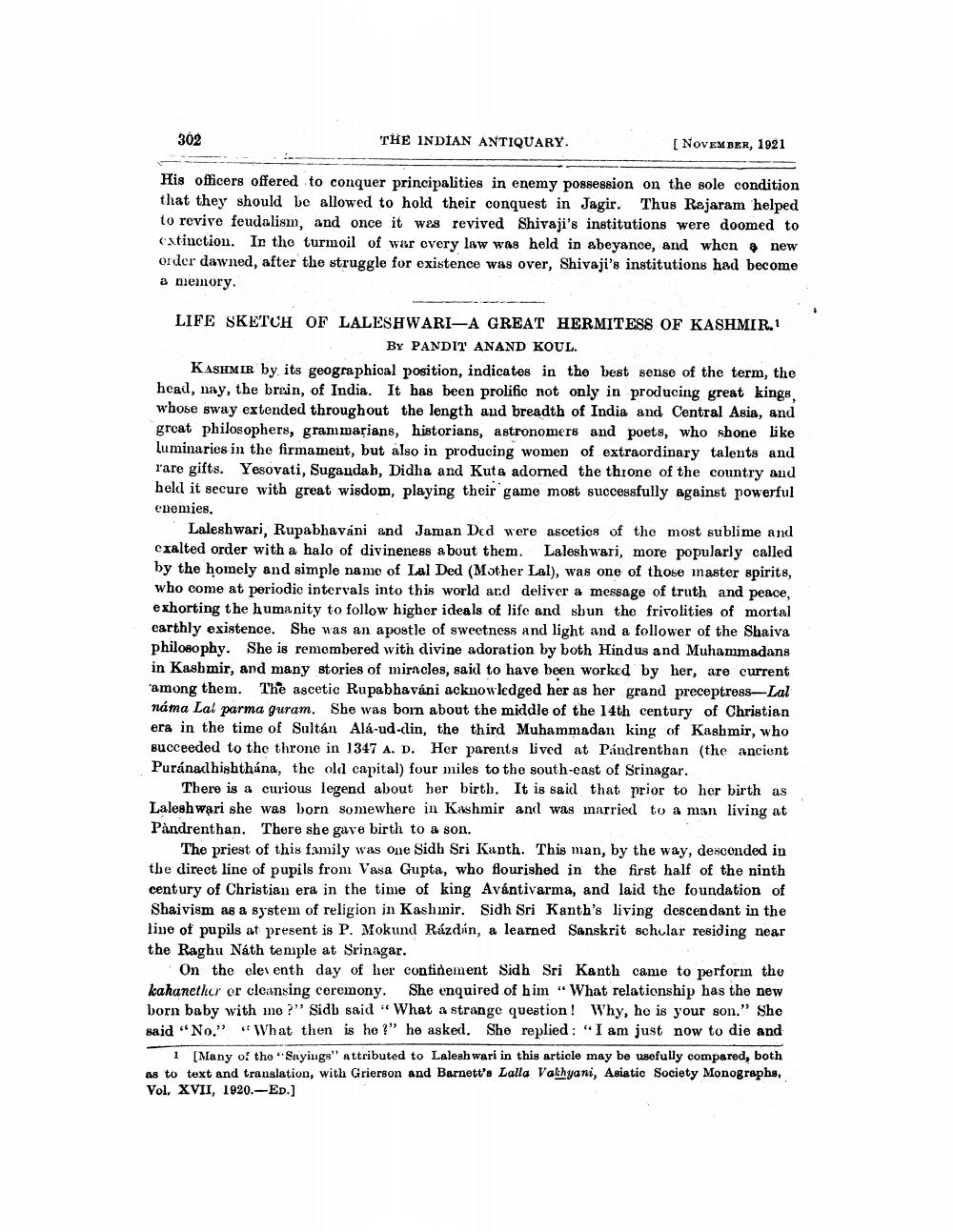________________
302
THE INDIAN ANTIQUARY.
[ NOVEMBER, 1921
His officers offered to conquer principalities in enemy possession on the sole condition that they should be allowed to hold their conquest in Jagir. Thus Rajaram helped to revive feudalism, and once it was revived Shivaji's institutions were doomed to extinction. In the turmoil of war overy law was held in abeyance, and when new order dawned, after the struggle for existence was over, Shivaji's institutions had become a niemory
LIFE SKETCH OF LALESHWARI-A GREAT HERMITESS OF KASHMIR.1
BY PANDIT ANAND KOUL. KASHMIR by its geographical position, indicates in the best sense of the term, the head, nay, the brain, of India. It has been prolific not only in producing great kings, whose sway extended throughout the length and breadth of India and Central Asia, and great philosophers, grammarians, historians, astronomers and poets, who shone like luminaries in the firmament, but also in producing women of extraordinary talents and rare gifts. Yesovati, Sugaudah, Didha and Kuta adorned the throne of the country and held it secure with great wisdom, playing their game most successfully against powerful enemies.
Laleshwari, Rupabhaváni and Jaman Ded were ascetion of the most sublime and cxalted order with a halo of divineness about them. Laleshwari, more popularly called by the homely and simple name of Lal Ded (Mother Lal), was one of those master spirits, who come at periodic intervals into this world ard deliver a message of truth and peace, exhorting the humanity to follow higher ideals of life and sun the frivolities of mortal carthly existence. She was an apostle of sweetness and light and a follower of the Shaiva philosophy. She is remembered with divine adoration by both Hindus and Muhammadans in Kashmir, and many stories of miracles, said to have been worked by her, are current among them. The ascetic Rupabhaváni acknowledged her as her grand preceptress-Lal náma Lal parma guram. She was born about the middle of the 14th century of Christian era in the time of Sultán Alá-ud-din, the third Muhammadan king of Kashmir, who succeeded to the throne in 1347 A. D. Her parents lived at Pandrenthan (the ancient Puránadhishthúna, the old capital) four miles to the south-east of Srinagar.
There is a curious legend about her birth. It is said that prior to her birth as Laleshwari she was born somewhere in Kashmir and was married to a man living at Påndrenthan. There she gave birth to a son.
The priest of this family was one Sidh Sri Kanth. This man, by the way, desconded in the direct line of pupils from Vasa Gupta, who flourished in the first half of the ninth century of Christian era in the time of king Avántivarma, and laid the foundation of Shaivism as a system of religion in Kashmir. Sidh Sri Kanth's living descendant in the line of pupils at present is P. Mokund Rázdán, a learned Sanskrit schular residing near the Raghu Náth temple at Srinagar.
On the clei enth day of her confinement Sidh Sri Kanth came to perform the kahanether or cleansing ceremony. She enquired of him "What relationship has the new born baby with mo?" Sidb said "What a strange question! Why, he is your son." She said "No." "What then is ho?" he asked. She replied: "I am just now to die and
1 (Many or the "Sayings" attributed to Laleah wari in this article may be usefully compared, both as to text and translation, with Grierson and Barnett's Lalla Vakhyani, Asiatic Society Monographs, Vol. XVII, 1920.-ED.)




